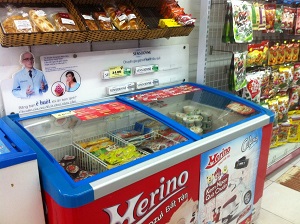Shopper marketers know that part of their job is to communicate effectively to shoppers while the shopper is in the store. Often lots of effort is put into getting the right communication message (sometimes not so much, too!), but in our experience one area of in-store communication planning is overlooked more than any other. Not the message, nor the choice of media, but the placement of the communication message.
In-store communication – location is key
The placement of the communication message is arguably the most important part of in-store communication planning. You might have a brilliant message and the perfect media vehicle, but if your target shoppers don’t see it, then all of that is irrelevant.
A great example of in-store communication
Take a look at this example from GSK in Vietnam. The execution is in a small urban convenience store, and it is promoting Sensodyne, a toothpaste for people with sensitive teeth. In this case GSK has decided to communicate to shoppers, not at the oral care fixture, but by the ice cream freezer. Why?
LEARN HOW TO CREATE POWERFUL INSTORE SIGNAGE AND SHOPPER COMMUNICATION THAT REALLY WORKS – NOW
Anyone who has sensitive teeth will understand why close to the ice cream freezer is a potentially good location: people with sensitive teeth know the awful pain that can occur when eating something cold. But why not put this in-store communication in the toothpaste aisle? Surely that would have been so much easier? Remember that this execution is in a convenience store. In this channel oral care is a very low traffic category, so while that might well have been a great location in terms of resonance with the shopper, the chances are that nobody would see it. Ice cream on the other hand, in a hot, humid city like Ho Chi Minh, is a high traffic location, so is likely to be in the path of so many shoppers.
Interestingly the same media and message was also used in supermarkets, but was sited in the oral care category. Why not put this execution by the freezer in the supermarket? Well – it could be that the oral care category was just seen as being a more relevant location for this message, but there is another factor too. In a large supermarket the journey from the freezer to oral care would have been longer. Would shoppers be bothered to walk back to oral care and pick up toothpaste? Perhaps not.
From this example we can identify a simple set of rules which can help identify the optimum placement for in-store communication
How to decide where to communicate with shoppers
Where can you find your target shoppers?
Clearly this presupposes that we know who our target shoppers are. Most shoppers do not visit large areas of the store, so we need to understand where in the store our target shoppers go and ensure we place our communication somewhere on this path. Little wonder that checkouts are so sought after: because all shoppers go there (and often hang around there for a while too!)
Where will the message resonate with your target shoppers?
Just because your message is in the path of the shopper, doesn’t mean it will register with them. Shoppers are deluged with messages and stimulus in a store, and they filter out most of what is thrown at them. Impactful creative is important, for sure, but context is also key. If you want to speak to your shopper about hair care, it might be best to have that conversation at a point in the store where hair care is important.
LEARN HOW TO CREATE POWERFUL INSTORE SIGNAGE AND SHOPPER COMMUNICATION THAT REALLY WORKS – NOW
These first two points create one of the most important decisions in communication placement: is my target shopper going to visit my category home shelf? If yes, then the home shelf may well be the best place to communicate with them: if not, then we will need to intercept them elsewhere.
Make it easy for your target shoppers to act (ideally buy!)
Lastly, having got our message across, we want to encourage the shopper to buy before they get hit with the next message. If we’re in the category home shelf location, this is simple: the product we want them to buy is close at hand. If not, we need to consider whether a secondary merchandising location is required.
Getting in-store communication right is more than just getting the brand message and putting it up in-store. Its more than jumping on the latest media options offered by your retailer partners. In-store communication needs careful planning and needs to be based on a clear understanding of who your target shopper is, what is their in-store behavior, and how (and where) you can best influence them.
For more about taking a more strategic approach to in-store marketing, check out our training and coaching programs now, or contact us for a chat.


